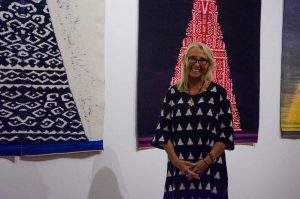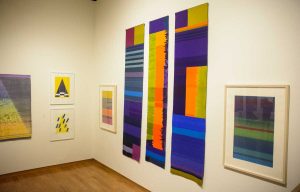In order to understand “Fault Lines,” a collection of tapestries and prints by Mary Zicafoose on display at the University of Mississippi Museum, one should probably read former U.S. Poet Laureate Ted Kooser’s poem “Tectonics.”
When Zicafoose first read “Tectonics” 10 years ago, she said she was blown away by the “brilliant contrast” Kooser created between the fading memory of a romantic relationship and land shifting to create a new world.
In one part of “Tectonics,” Kooser wrote, “After many years, even a love affair, one lush green island all to itself, perfectly detailed with even a candle softly lighting a smile, may slide under the waves like Atlantis, scarcely rippling the heart.”

Artist Mary Zicafoose stands in front of her “Fault Lines” exhibit displayed at the UM Museum from Oct. 3, 2017, to Feb. 3, 2018. She created the integrated series of weft-faced woven ikat tapestries with a theme driven by politics, human relationships and land movement. Photo by Marlee Crawford
“This poem captures the exhibit,” Zicafoose said. “The driving force behind (‘Fault Lines’) is the changes on Earth, and I think you can extrapolate that to personal relationships.”
Zicafoose’s use of ikat, a complex, ancient Malaysian weaving method in which one resist-dyes fibers before weaving them, and her “unabashed” use of color allow her to approach the movement of land masses in this abstract, humanistic manner.
“I remember reading that poem years ago and thinking there’s going to be a time for me to starting weaving about this,” Zicafoose said.
And that perfect time turned out to be a few years ago, Zicafoose said, considering the changing environmental state of the Earth and the fact that such changes have become a part of popular culture.
“The ‘Fault Line’ series is based on land mass and land formations changing and moving. Whether you agree with it or not, it’s happening — the climate is changing,” Zicafoose said. “And as it changes, there’s fallout in forms of tornadoes, earthquakes and all the disasters we’re experiencing.”
These environmental changes not only lead to disasters but also contribute to what will be the history of the planet. “Timeline,” one of the three tapestries making up the center triptych of the exhibit, conveys bright stripes representing the Earth’s development in conjunction with humanity.

The “Fault Lines” exhibit will be displayed at the UM Museum from Oct. 3, 2017, to Feb. 3, 2018. She created the integrated series of weft-faced woven ikat tapestries with a theme driven by politics, human relationships and land movement. Photo by Marlee Crawford
“When you go to the Grand Canyon, you see all of the lines — the Paleolithic period, the Neolithic period — you literally see the timeline of man on this planet,” Zicafoose said. “Where are we on that timeline? Which segment is 2017? How many more segments are going to be up on top of us?”
Similarly to Kooser, Zicafoose feels these land plates represent more than the timeline of the world — they also represent personal relationships. The title, “Fault Lines,” in fact, is a play on words, because lines also represent the unspoken boundaries within a relationship and the idea of blame — Whose fault is it?”
“The Earth is no different than the humans on it — we’re all shifting and changing at the same time,” Zicafoose said.
The collection also includes many pieces from Zicafoose’s five-yearlong series, “Mountain for the Buddha,” which references landscape, geometry and sacred space.
“I tend to work around classic archetypal symbols, so the symbol this is based on is the triangle, the temple, the triad, the trinity, the three angles,” Zicafoose said. “It’s got a lot of spiritual symbolism and environmental symbolism since it resembles a mountain.”
One of these works, “Mountain for the Buddha- Envy,” includes a triangle filled with intricate black and white mazes on top of a deep green background. This piece was guided by Zicafoose’s intuition. When she started, she didn’t know the name, but then the color began to influence meaning.
“The piece just started to emerge as I was making it, and it became really clear that this maze is envy,” Zicafoose said. “You get caught in this emotional maze, and you can’t get out. You’re locked into this nightmarish thought form of envy.”

The “Fault Lines” exhibit displayed at the UM Museum from Oct. 3, 2017, to Feb. 3, 2018. She created the integrated series of weft-faced woven ikat tapestries with a theme driven by politics, human relationships and land movement. Photo by Marlee Crawford
Lastly, Zicafoose replicated her own fingerprints to explore themes of self-identity in “Blueprint.”
Museum director Robert Saarnio said the museum is thrilled to present the work of this internationally renowned tapestry artist and rug weaver.
“Mary’s pieces are exceptionally vibrant and also elegantly simple,” Saarnio said. “We were compelled by her description of her work: ‘I create contemporary tapestry, pushing the boundary of this ancient art form, to investigate the intricacies of how we, as individuals, are tied to one another.’”
If you missed Zicafoose’s art reception last night, don’t worry — she’ll return to Oxford from Omaha, Nebraska, in a few months for the eighth annual Oxford Fiber Arts Festival Jan. 25-28. Her exhibit is on display at UM Museum until next February.






